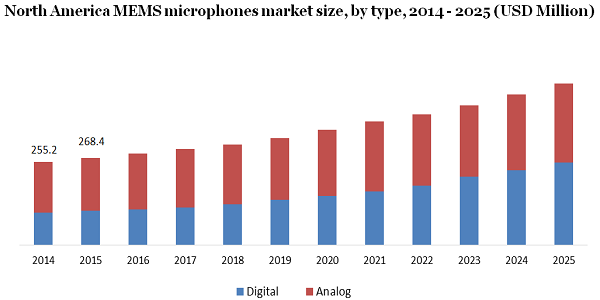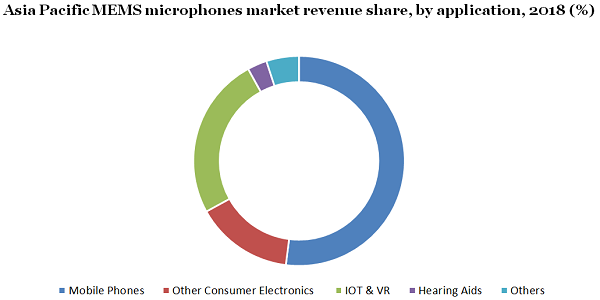- US: +1-408-610-2300
- Toll Free: +1-866-831-4085
- Become a Client
The global MEMS microphones market size was worth USD 1,207.7 million in the year 2018. It is expected to register a CAGR of 14.4% over the forecast period. The upsurge is due to the rising demand for IoT-enabled devices, smartphones, hearing aids, virtual reality (VR) headsets, and various consumer electronics along with the smart city initiatives across the globe. The increasing disposable income that has stimulated the demand for smartphones is likely to be the key factor boosting the product demand. Simultaneously, the increasing aging population, dealing with hearing impairment, has boosted the demand for hearing aids incorporated with advanced-quality microphones, which is further anticipated to propel the market growth by 2025.

The introduction of piezoelectric technology has led to the production of MEMS microphones with better SNR i.e., signal-to-noise ratio ranging 64dB to 66Db, generally suitable for far-field audio uses to recognize the sound from its background. These microphones are regarded as sturdy, durable, tolerant to moisture and dust, and power-efficient. However, improved SNR MEMS microphones were not compatible with smartphones. Therefore, piezoelectric technology-based microphones are presently restricted to portable smart speakers and controlled devices.
The growth of IoT-based smart devices and virtual reality (VR) has created new avenues for market growth. MEMS microphones are generally used with IoT-enabled smart devices, like Amazon Echo smart speakers that function on speech voice recognition directions. The headsets enhancing the consumer experience for gaming and VR-based movies further incorporates MEMS microphones. These newer applications are anticipated to drive the product demand in the upcoming years.
Furthermore, the VR and IoT integrated microphones are paving their way for market growth in recent years. The integration intends to provide a delightful experience for consumers by engaging them in the virtual world. The development of the VR Star theme park, located in China, is solely based on envisaging consumers’ experience through this integration.
The increasing demand for different consumer electronics is further likely to augment the MEMS microphone market growth. These electronics consist of tablets, portable media players, personal computers, speech recognition systems, music recorders, surveillance cameras, radars, 3D cameras, anti-theft alarms, smart speakers, headphones, and several home appliances, like air conditioners, service robots, and refrigerators. Increasing the overall effect by scraping unwanted background sound is of vital importance for the used electronics. Therefore, microphones adopted in these electronics are required to have unique and special features.
The analog segment is poised to observe rapid growth from 2019 to 2025 due to fueling demand for analog output-based microphones used in many smartphones. These generally account for around 70% to 80% of the worldwide market currently. Samsung is solely adopting digital MEMS microphones in smartphones.
The digital segment is less sensitive and more expensive to electromagnetic interference. Therefore, these are highly suitable for laptops, mainly owing to their sustainability against friction by the liquid crystal display units. Moreover, this segment is likely to account for substantial growth against the analog segment. A majority of the MEMS microphones introduced over the years would be incorporated with digital microphones while analog-enabled microphones would turn obsolete.
The very high i.e. >=64dB segment incorporates noise with superior audio quality and has the ability to differentiate a sound from its background. Therefore, these are generally adopted to capture noise from distant areas. The segment is poised to witness substantial growth followed by the high and low segments.
The high SNR MEMS microphones are generally used in tablets, camcorders, smartphones, earphones, and laptops. These were subsequently popular till the launch of piezoelectric technology-based microphones with improved SNR. The low SNR MEMS microphones of <=59dB provide better or similar audio quality than the electret condensers. Their small size is an additional benefit as it provides improved functioning of such devices.
The capacitive segment has traditionally led the MEMS microphone market and is regarded to be highly preferred for high (>= 64 dB) SNR MEMS microphones owing to its precise size and form. Microphones enabled with capacitive technology acquired noise transducer for the free movement against high noise pressure, thus, controlling the microphone’s performance.
Meanwhile, piezoelectric technology provides improved SNR owing to the incorporation of scandium-based AIN film, which further contributes to removing noise damping. These products aid constant performance and are less prone to deterioration even for a longer duration. Furthermore, they are independent of the capacitive gaps that might be sensitive to moisture and dust and thus, enable swift pick-up time. The segment is poised to gain traction by 2025 due to fueling demand for usage in devices like car infotainment systems, loudspeakers, and portable smart speakers.
The hearing aids, IoT & VR, and other electronics segments are expected to witness high growth from 2019 to 2025. An increase in disposable income, mainly in developing countries has resulted in a higher demand for consumer electronics and smartphones. This is further likely to surge the use of MEMS microphones in smartphones in the upcoming years. Similarly, technological developments have opened avenues for the integration of VR platforms and IoT, thus, boosting the demand for superior-quality microphones.

The other division covers end-use verticals and industries including construction, telepresence, automation, manufacturing, medical telemetry, and oil & gas. These industries and verticals are likely to adopt MEMS microphones over the forecast years. For example, MEMS microphones are used in the automotive sector as wireless radio technology to track the respiration and pulse rates of patients and increase alerts during emergencies.
The Asia Pacific held the largest market due to the presence of established manufacturing services in the Philippines, Thailand, and China. The regional market is likely to account for the highest CAGR from 2019 to 2025 due to constant advances in hearing aids, smartphones, other electronics, and VR & IoT devices. Middle East & Africa is also poised to register substantial growth owing to various hackathon programs initiated to increase the popularity of the VR technology, in turn, fueling the demand for MEMS microphones.
The demand for MEMS microphones has witnessed a significant decline following the outbreak of COVID-19. The pandemic has resulted in shutting down several semiconductor-based manufacturing industries, thereby, disrupting the supply chain. Further, China is a leading manufacturer of MEMS microphones and several semiconductors companies have shifted their manufacturing base out of China, thus, reducing over-reliance on China. Additionally, governments across the world introduced lockdown that resulted in a significant decline in demand for MEMS microphones.
The industry is consolidated with some organizations holding the majority of shares. The key players have opted for inorganic growth strategies like partnerships and R&D activities to combat competition. Furthermore, they are improving the distribution schemes by integrating with distributors with a global presence.
Additionally, manufacturers are focusing on establishing a chain of partners across different nations to enhance their market presence. For example, CUI Inc., Signed a distribution contract with Arrow Electronics, Inc. and Master Electronics, while DB Unlimited entered into an agreement with Symmetry Electronics. The key players include:
• Knowles LLC
• InvenSense, Inc.
• STMicroelectronics; Cirrus Logic, Inc.
• CUI, Inc.
• Infineon Technologies AG
• AAC Technologies
• Goertek
• Vesper Technologies Inc.
|
Report Attribute |
Details |
|
The market size value in 2020 |
USD 1,483.6 million |
|
The revenue forecast in 2025 |
USD 2,991.0 million |
|
Growth Rate |
CAGR of 14.4% from 2019 to 2025 |
|
The base year for estimation |
2018 |
|
Historical data |
2014 - 2017 |
|
Forecast period |
2019 - 2025 |
|
Quantitative units |
Volume in million units, revenue in USD million, and CAGR from 2019 to 2025 |
|
Report coverage |
Revenue forecast, company ranking, competitive landscape, growth factors, and trends |
|
Segments covered |
Type, SNR, technology, application, region |
|
Regional scope |
North America; Europe; Asia Pacific; Latin America; MEA |
|
Country scope |
U.S.; Canada; U.K.; Germany; India; Japan; China; Brazil; Colombia |
|
Key companies profiled |
Knowles LLC; InvenSense, Inc.; STMicroelectronics; Cirrus Logic, Inc.; CUI, Inc.; Infineon Technologies AG; AAC Technologies; Goertek; Vesper Technologies Inc. |
|
Customization scope |
Free report customization (equivalent to up to 8 analysts’ working days) with purchase. Addition or alteration to country, regional & segment scope. |
|
Pricing and purchase options |
Avail of customized purchase options to meet your exact research needs. |
This report forecasts revenue growth at global, regional, and country levels and provides an analysis of the latest industry trends in each of the sub-segments from 2014 to 2025. For the purpose of this study, Million Insights has segmented the global MEMS microphones market report based on type, SNR, technology, application, and region:
• Type Outlook (Volume, Million Units; Revenue, USD Million, 2014 - 2025)
• Digital
• Analog
• SNR Outlook (Volume, Million Units; Revenue, USD Million, 2014 - 2025)
• Very high (>=64dB)
• High (>=60 dB, < 64 dB)
• Low (<= 59 dB)
• Technology Outlook (Volume, Million Units; Revenue, USD Million, 2014 - 2025)
• Capacitive
• Piezoelectric
• Application Outlook (Volume, Million Units; Revenue, USD Million, 2014 - 2025)
• Mobile Phones
• Other Consumer Electronics
• IoT & VR
• Hearing Aids
• Others
• Regional Outlook (Volume, Million Units; Revenue, USD Million, 2014 - 2025)
• North America
• U.S.
• Canada
• Europe
• Germany
• U.K.
• the Asia Pacific
• China
• India
• Japan
• Latin America
• Brazil
• Colombia
• Middle East & Africa (MEA)


Research Support Specialist, USA